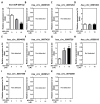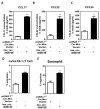Circular RNA hsa_circ_0008726 Targets the hsa-miR-206-3p/KLF4 Axis to Modulate 4,4'-Methylene Diphenyl Diisocyanate-Glutathione Conjugate-Induced Chemokine Transcription in Macrophages
- PMID: 39451243
- PMCID: PMC11505732
- DOI: 10.3390/cells13201725
Circular RNA hsa_circ_0008726 Targets the hsa-miR-206-3p/KLF4 Axis to Modulate 4,4'-Methylene Diphenyl Diisocyanate-Glutathione Conjugate-Induced Chemokine Transcription in Macrophages
Abstract
Exposure to 4,4'-methylene diphenyl diisocyanate (MDI) in the workplace may lead to the development of occupational asthma (OA). However, the specific mechanism(s) by which MDI induces OA are poorly understood. Previous reports have demonstrated that MDI and MDI-glutathione (GSH) conjugate exposure downregulates endogenous human/murine (hsa/mmu)-microRNA(miR)-206-3p, resulting in the activation of mmu/hsa-miR-206-3p-regulated signaling pathways in macrophages. Circular RNAs (circRNAs) regulate many important biological processes by targeting endogenous miRs; however, whether MDI/MDI-GSH exposure may influence circRNA expressions is unknown. Several circRNAs have been identified that regulate hsa-miR-206-3p. We hypothesize that MDI-GSH conjugate exposure induces endogenous circRNA(s) to regulate hsa-miR-206-3p in macrophages. The expression of candidate hsa-miR-206-3p-binding circRNAs was determined from MDI-GSH conjugate-treated differentiated THP-1 macrophages using RT-qPCR. MDI-GSH exposures induced hsa_circ_0008726 and its host gene transcript DNAJB6, whereas other circRNA(s) examined were either not detected or unchanged. RNA-induced silencing complex-immunoprecipitation (RISC-IP) experiments confirm that hsa-miR-206-3p can bind to hsa_circ_0008726. The expressions of endogenous hsa-miR-206-3p, hsa-miR-206-3p-regulated KLF4, and KLF4-activated M2 macrophage-associated markers and chemokines were up-/down-regulated by transfection of hsa_circ_0008726 siRNAs or hsa_circ_0008726 overexpression plasmid in macrophages, respectively. These results suggest MDI-GSH exposure downregulates hsa-miR-206-3p via induction of endogenous hsa_circ_0008726/DNAJB6, resulting in the upregulation of hsa-miR-206-3p-mediated regulations in macrophages.
Keywords: 4,4′-methylene diphenyl diisocyanate (MDI); Krüppel-like factor 4 (KLF4); circular RNAs (circRNAs); hsa-miR-206-3p; occupational asthma (OA).
Conflict of interest statement
The authors declare that they have no conflicting financial interests. The findings and conclusions in this report are those of the authors and do not necessarily represent the official position of the National Institute for Occupational Safety and Health, Centers for Disease Control and Prevention.
Figures








Similar articles
-
MicroRNA-mediated Krüppel-like factor 4 upregulation induces alternatively activated macrophage-associated marker and chemokine transcription in 4,4'-methylene diphenyl diisocyanate exposed macrophages.Xenobiotica. 2024 Sep;54(9):730-748. doi: 10.1080/00498254.2024.2334329. Epub 2024 Apr 19. Xenobiotica. 2024. PMID: 38568505 Free PMC article.
-
Circular RNA hsa_circ_0099188 Regulates Inducible Nitric Oxide Synthase and Chemokine Transcription in Macrophages by Targeting the hsa-miR-381-3p/PPP3CA and hsa-miR-381-3p/KLF4 Pathways in Response to 4,4'-Methylene Diphenyl Diisocyanate-Glutathione Conjugate exposure.Toxicol Sci. 2025 Aug 11:kfaf114. doi: 10.1093/toxsci/kfaf114. Online ahead of print. Toxicol Sci. 2025. PMID: 40796177
-
MicroRNA-mediated calcineurin signaling activation induces CCL2, CCL3, CCL5, IL8, and chemotactic activities in 4,4'-methylene diphenyl diisocyanate exposed macrophages.Xenobiotica. 2021 Dec;51(12):1436-1452. doi: 10.1080/00498254.2021.2005851. Epub 2021 Dec 2. Xenobiotica. 2021. PMID: 34775880 Free PMC article.
-
New mechanisms in diisocyanate-mediated allergy/toxicity: are microRNAs in play?Curr Opin Allergy Clin Immunol. 2025 Apr 1;25(2):75-82. doi: 10.1097/ACI.0000000000001043. Epub 2024 Oct 23. Curr Opin Allergy Clin Immunol. 2025. PMID: 39450940 Free PMC article. Review.
-
Emerging Roles of Circular RNA in Macrophage Activation and Inflammatory Lung Responses.Cells. 2024 Aug 23;13(17):1407. doi: 10.3390/cells13171407. Cells. 2024. PMID: 39272979 Free PMC article. Review.
References
-
- Allport D.C., Gilbert D.S., Outterside S.M. MDI and TDI: A Safety, Health and the Environment: A Source Book and Practical Guide. J. Wiley; New York, NY, USA: 2003.
-
- Statista Demand for Methylene Diphenyl Diisocyanate Worldwide from 2011 to 2023. 2024. [(accessed on 10 October 2024)]. Available online: https://www.statista.com/statistics/750809/mdi-demand-worldwide/
-
- NIOSH Letter from NIOSH to Distinctive Designs International Inc. with a Study Report. [(accessed on 10 October 2024)];1994 Available online: https://www.cdc.gov/niosh/hhe/reports/pdfs/1991-0386-2427.pdf.
Publication types
MeSH terms
Substances
Grants and funding
LinkOut - more resources
Full Text Sources

